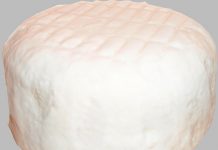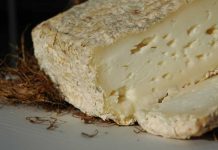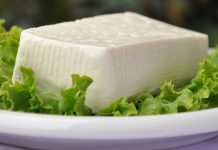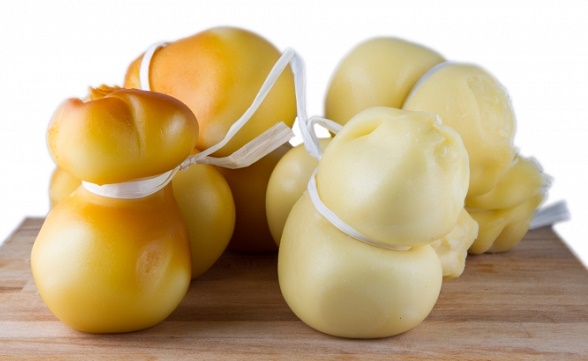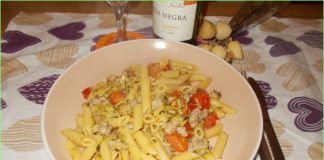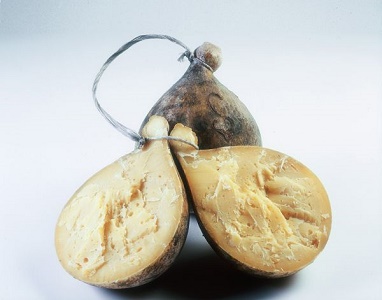
Description and history
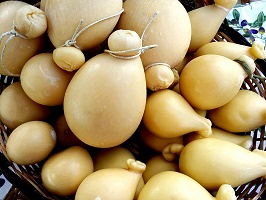
The Caciocavallo is one of the oldest cheeses in southern Italy and most likely Hippocrates referred to this food by illustrating the art for the preparation of cheese by the Greeks.
This product arises from the spun pasta technique tested and perfected in the south, in order to preserve longer the cow’s milk cheese.
The curd is obtained through heating and in turn the coagulation of milk which undergoes a second time a further cooking to become of elastic consistency, to be manipulated with ease and without breaking.
The cheese shape is elongated and round with a head on top, with the same consistency of all the spun pasta cheese, and can become brittle and scaly like a “parmesan” cheese, if undergoes a maturation period of about three years.
As regards the origin of the name “Caciocavallo”, the hypotheses have been many in the course of time, and a theory, says that this term would derive from a tax mold in a horseshoe form, present in 1500 for many products derived from the processing of milk.
Many linked the name to the shipping method that was used at one time by the shepherds, who placed the cheese in pairs over the horse’s rump, while other hypotheses were inspired by the fact that the Provola cheeses were tied at the turn of a rush for the period of maturation, for which was used the Italian term “on the horse”.
Caciocavallo cheese is a typical product of the south and other sources says that its term seems to derive from the custom of hanging the cheeses to dry, tied in pairs, riding on a beam, or to shape the dough into a horse.
According to other sources however, this name seems to have been born at the time of the Kingdom of Naples, when it was in use at the time, to impress on the outside of the cheese, a mark representing a horse.
Today, the term “Caciocavallo” comes from the Greek word “qasqawal”, a type of cheese similar to this one.
The Caciocavallo most popular on the market today are: the Caciocavallo of Agnone, cheese with very young origins, the Caciocavallo Podolian, unobtainable on the market for the breeding decline of Podolian cows, and lastly the caciocavallo Silano, that since 1996, has acquired the DOP of Protected Designation of Origin.
Among the many products made with the same type of processing of the cheese, there is also the “Bebè” (baby), and is a dairy product which is also very elongated, only with two heads at the top, one of which is larger than all other.
The particular shape resembles a child in swaddling clothes, that’s why his name.
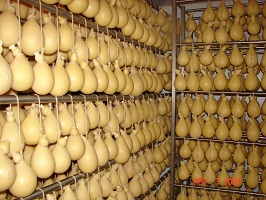
This product is very young, very recently was introduced on the market, especially in the tourist areas of the coast of Amalfi and Sorrento, and the production area is limited exclusively to the Naples area.
The Bebè is consumed basically fresh, after a brief few days of maturation and as such is greatly appreciated and often preferred to the Caciocavallo, thanks to its neutral taste and its more delicate texture.
If realized through the milk of Podolian cows bred in the wild or semi-wild, is an extremely valuable food, because the animal’s diet is extremely varied and rich, typical of the Mediterranean zones. The cheese-making process is carried out very often in the farms.
Production phase and characteristics
The Caciocavallo is a spun pasta cheese that requires a maturation for about 3 or 4 months and in the production phase, the fresh milk is heated to a temperature which is around 50-60 degrees to then be added to the remainder milk that has been filtered in advance, so as to reach a temperature not exceeding 40 degrees.
After this processing, the milk is added with the calf’s liquid rennet, to provide a sweet Caciocavallo, a very delicate aftertaste, or with rennet paste of kid or lamb, to obtain a hot product.
The time for obtaining the curd is around 30 minutes, and in the next phase, this is cut initially in two parts, then broken up to obtain a compound lumpy the size of a grain of corn.
It follows a rest period of about half an hour and after the serum is extracted which is heated to 60 degrees and is added to the dough.
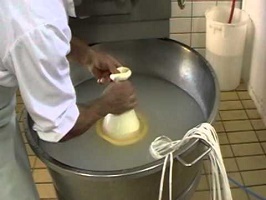
This process is repeated twice, adding slowly the serum.
Once reached the maturation, the curds are extracted and put to dry for about one hour on a level that is called “topagno” and is first cut into large slices, then in the next stage in the thinner pieces that they are placed in a “Tinaccio”, where it is processed with boiling water to about 85 degrees.
The curd is worked to obtain an ideal consistency for spinning, and giving initially a semi-spherical shape of the weight of 2.5 kilograms.
Continue giving the dairy product the typical form of cheese ovoid, with a strangulated appendix which is then closed apex.
The Caciocavallo are tied in pairs and subjected to drying for a minimum of 15 days time, over a perch.
After this period, the Caciocavallo is aged in the cellars for a minimum of 3-6 months, for a maximum of one year.
Caciocavallo cheese can be sweet or spicy, depending on the type of curd which is used in the process of realization.
Sicilian Caciocavallo
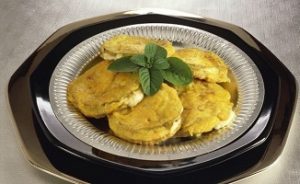
There are two types of Caciocavallo in Sicily, the first is also said the Palermo Godrano, the second is the Ragusano Caciocavallo which has the DOP, in the area of Ragusa. Eastern Sicily.
Both products are made with very similar methods, but despite this there are differences related to the area of origin.
The first Caciocavallo, is mainly achieved through the use of Cinisara breed of cow’s milk, the autochthonous black coat, and is part of Podolica Italian races.
Ragusano of protected designation of origin, is produced in the Iblei mountains, using the milk of Modica cows.
The plateau of Iblei, occupies a large south eastern part of Sicily and slopes towards the south, with the presence of see pastures and cultivated fields, until it touches the sand and dunes with natural vegetation of the coastal strip of the region.
The countryside of Ragusa, characterized by limestone and a characteristic dry stone walls, moves between the ancient carob, among the typical rural architecture of farms, among olive groves and vineyards, until you reach the rugged pastures and natural, but very rich fodder where cows wander freely of Modica breed.

